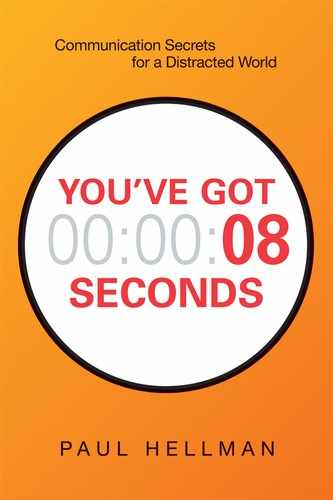|CHAPTER 12|
Ten Actions to Increase Your Presence: Assess Yourself
“I’ve missed more than 9,000 shots in my career. I’ve lost almost 300 games. 26 times, I’ve been trusted to take the game winning shot and missed. I’ve failed over and over and over again in my life. And that is why I succeed.”
—MICHAEL JORDAN, basketball star
Let’s take this vague notion of presence and make it more specific and actionable.
Review the 10 items that follow, which we’ll group into three themes:
1.Your image
2.Your drive
3.Your temperament
What are you doing well? Find two to three items. What could you do better? Find two to three items. How do your colleagues see you? Ask them.
Or, if you prefer, score each item on a 1–10 scale (1 low; 5 average; 10 high). You can give the same score to different items, but avoid giving everything a 5.
It’s important with lists like this to avoid being overly self-critical. No one is great at everything. What are your strengths? Build on them.
Note: These 10 items are not a definition of leadership (leaders need presence, so all the items apply, but so do other items not on this list). And it’s certainly not the last word. Executive presence varies across organizations, cultures, and countries.
This list is grounded in my consulting work, over 25 years, with executives and managers at leading companies and, although not scientific, it’s been tested with more than a thousand workshop participants.
Here’s what we’re trying to figure out: What is it about you and your presence that makes others listen, or not listen? These 10 items will give you some actionable ideas.
Your image:
1.Nonverbals: Projects confidence with voice and body language. (Voice: volume, speed, pitch, pauses, clarity. Body language: facial expression, eye contact, posture, movement, gestures.)
2.Optics: Attends to physical appearance, office appearance, social media appearance, as well as language and behavior in formal and informal settings to set high standards.
Your drive:
3.Focus: Stays focused at meetings and at work on what’s most important. Is fully present. Gives the right amount of detail to the right audiences.
4.Energy: Projects physical, emotional, and mental energy (physical means you’re animated; emotional, you care; mental, you’re alert). Sustains energy over time.
5.Initiative: Offers ideas and suggestions to continuously improve and innovate. Experiments with new approaches, takes calculated risks. Is proactive.
6.Commitment: Makes and keeps commitments. Takes responsibility for getting things done. Stays true to one’s values. Persists, persists, persists.
Your temperament:
7.Humility: Admits and learns from mistakes. Seeks and values others’ ideas and involvement. Listens with respect. Shares credit.
8.Command: Takes the lead. Speaks up. Asserts oneself skillfully, without either aggression or undue concern for being liked or agreed with.
9.Optimism: Takes a positive approach to problems and tasks. Imagines and communicates a positive, credible future state.
10.Composure: Demonstrates calm under pressure. Handles stressful situations well. Thinks on one’s feet, improvises. Uses humor appropriately.
These 10 items, of course, interact. For example, your optimism influences your energy. (Ever feel hopeless? That’s generally not a high-energy state.)
Back to the three themes. They’re based on three questions your audience is trying to assess (be the audience).
Three Themes |
Based on Three Questions |
1. Image |
1. Do you look and sound the part? |
2. Drive |
2. Do you get results? |
3. Temperament |
3. Do you have the right disposition? |
In the following chapters, we’ll look at some examples, good and bad, of these 10 items. Notice how fast they work. Often, in seconds.
